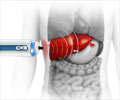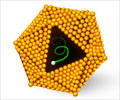Researchers have discovered a new pathway in the liver that opens the door to treat non-alcoholic fatty liver disease.

- An enzyme, CYP2E1, is known to be a major contributor to non-alcoholic liver disease (NAFLD) and its progression.
- Researchers found a protein TRPV4, that activates the release of nitric oxide.
- The nitric oxide then block the enzyme CYP2E1 thus preventing injury in NAFLD.
NAFLD occurs in about 25% of the population and may lead to other conditions like cirrhosis, liver failure or eventually cancer.
This condition affects individuals who are overweight or obese or those having higher levels of cholesterol, triglycerides and type 2 diabetes. It occurs in both children and adults.
But some people develop non-alcoholic fatty liver disease without any of these risk factors which may suggest genetic involvement.
Researchers from the University of South Carolina, Duke University, University of Alabama at Birmingham, and Metabolon Inc. Research Triangle Park have discovered a new pathway in the liver that opens the door to treat NAFLD.
A protein (TRPV4), is a part of the body’s defense system and is known to provide protection against cardiovascular diseases. TRPV4 was found to activate the release of a gas (nitric oxide). This gas then blocks one of the enzymes (CYP2E1) that is a major contributor to non-alcoholic liver disease and its progression.
Researchers want to test TRPV4 agonists to improve outcomes related to non-alcoholic fatty liver disease. An agonist is a chemical that will bind to this protein and activate the release of nitric oxide to block the harmful enzyme. The appropriate agonist can be incorporated into medication for clinical treatment.
"There are currently no clinically proven drugs to treat non-alcoholic fatty liver disease," says Saurabh Chatterjee, an associate professor of environmental health sciences at the University of South Carolina's Arnold School of Public Health and the director of the Environmental Health and Disease Laboratory where the research was led. "Our goal is to find novel pathways in the liver that will result in a road to a cure, and this novel internal defense mechanism within the liver offers a very promising route."
Inhibiting TRPV4 with Caution
There are some harmful actions that can inhibit the TRPV4 ion channel and enhance hepatotoxicity or liver damage by harmful chemicals. This can be due to over consumption of alcohol or excess use of pain-killers and anti-inflammatory drugs like acetaminophen.
"This means that one has to be careful when aiming to inhibit TRPV4 for therapeutic purposes, such as when treating pain, inflammation or itching, or other conditions, in particular when inhibiting TRPV4 by systemic application of TRPV4-blockers," says Wolfgang Liedtke, a professor of neurology, anesthesiology and neurobiology at Duke University School of Medicine who first described TRPV4 16 years ago.
Liedtke, suggests that it would be ideal to use herbal-derived TRPV4-activating compounds that might be more 'gentle' when treating non-alcoholic fatty liver disease.
Sometimes to manage pain or inflammation and conditions like fibrotic diseases or lung edema, systemic inhibition of TRPV4 is necessary, but it should be using methods that prevent additional damage to the liver.
This type of research, which seeks novel pathways for treatment of diseases that currently have no therapeutic options is vitally important as it will have significant impact for both the individuals and public health.
The study was published in Free Radical Biology & Medicine.
Reference
- Saurabh Chatterjee et al. TRPV4 activation of endothelial nitric oxide synthase resists nonalcoholic fatty liver disease by blocking CYP2E1-mediated redox toxicity. Free Radical Biology & Medicine; (2016) DOI:10.1016/j.freeradbiomed.2016.11.047
Source-Medindia















